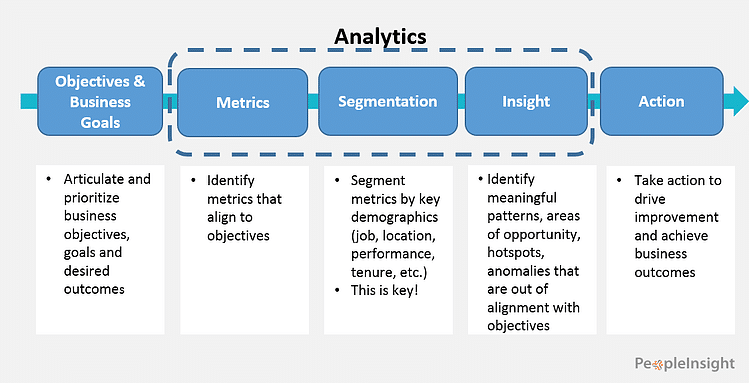With people analytics, human resources teams reclaim time and resources. They think and act more strategically. And they elevate their conversations with executives so they’re aligned to business objectives.
HR analytics go beyond HR
What’s the value of people analytics outside of HR…? Put another way, what does HR analytics contribute to the business at large? This is where things really get exciting. Comprehensive analytics provide insight into how things are / are not working within the business. And these insights drive improved performance.
However, to ensure HR analytics add the most value, use them in the context of business objectives and outcomes. people analytics can overwhelm and it’s easy to get lost in all the numbers and data. So focus is critical. HR analytics for the sake of analytics is just numbers. You need a plan, which involves wisely tackling defined business objectives.
A Helpful Framework
Think of analytics within a broader context, one with business objectives at one end and business outcomes at the other. As a result, this framing supports HR analytics beyond just HR. Instead, it shows the value to HR and the organization as a whole.

In 5 Major Buckets:
1. Objectives & Business Goals – For maximum efficacy, link people analytics to business goals. Articulate and prioritize business objectives, goals and desired outcomes. Objectives may relate to turnover reduction, understanding turnover by segment, and associated costs. Succession planning is another for focus. Whatever your top objectives, keep them at the forefront and use your HR analytics solution to bring insight to these areas.
The next 3 fall under the umbrella of Analytics:
2. Metrics – Identify the metrics needed that align to the objectives. Sometimes this requires data outside of HR and inside.
3. Segmentation – Equipped with all the metrics and data relevant to your objective, you can start to slice and dice the data across the variables. And with connected data you can dig deeply into turnover. Broad numbers, for example company-wide turnover of 12%, are now dissectable with precision. Look at turnover by demographics, tenure, performance, engagement, learning, location, job/role… really any area where you capture data. This turns a generic turnover understanding into a very specific one. For example, top performer turnover for a particular role is 33% with an impact of $1.5M in annual lost revenue. Instead of talking about one number with little context (12%), you now understand turnover by performance and role PLUS the cost of this to the business. And… you have a target to make decisions and take action.
4. Insight – Once you segment the data, it’s time to start drawing insights from it. This means looking for patterns that support business objectives. It also means looking for anomalies, hotspots and areas out of alignments with business objectives.
And last but certainly not least:
5. Action – Armed with deep analytics and insight into business problems, HR teams have the knowledge to take action and drive towards improved business performance.
In Conclusion
With highly targeted insight into your business objectives (whether reduce turnover, increas engagement, succession plans, understand quality of hire, etc.) you can tackle these issues head-on. And in the most efficient and effective ways. Use the example above. If segmentation reveals turnover is a problem in three specific groups of employees, and you know impact to the business is worse in one of those, you know where to focus first.
Applying people analytics to HR data is exciting, but it’s easy to get lost in all the data. That’s why it’s essential to approach HR analytics within the context of defined business objectives. Take the time to identify and share your objectives in HR. Then use your analytics solution to segment and understand priority areas. From here, you’ll develop a data-driven view, tell a compelling story of what’s happening, and yield the insights to chart the way forward. Schedule a demo and learn more.